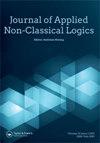Selecting accepted assertions in partially ordered inconsistent DL-Lite knowledge bases
Q1 Arts and Humanities
引用次数: 0
Abstract
The problem of inconsistency handling in knowledge bases has received considerable research attention in several settings and has met many applications. Inconsistency usually stems from the fact that the information available for reasoning, query answering and decision-making tasks is obtained from different, scattered and potentially unreliable information sources. Performing these tasks is often computationally expensive, especially for knowledge bases in which the data is endowed with preferences and/or uncertainty. In the context of formal ontologies, enriching the assertions (i.e. the data pieces) with conceptual knowledge makes the query answering task harder computationally. Tractable results have been successfully established for the lightweight languages of the DL-Lite family. In this paper, we present two tractable methods for handling inconsistency in partially ordered lightweight ontologies. In essence, both methods are inspired from the well-known Intersection of ABox Repair (IAR) semantics, which proceeds by replacing the initial inconsistent knowledge base with the intersection of all of its maximally consistent sub-bases. The first method assumes a partial preorder over the knowledge base and identifies the accepted assertions, called ‘elected’, in polynomial time in data complexity. The second method captures uncertainty quantitatively in the framework of possibility theory and identifies the so-called ‘π-accepted’ assertions, also in polynomial time in data complexity. However, both characterisations require the conflict set to be readily available. This constitutes a serious limitation in frameworks and applications where the conflict set cannot be exhibited efficiently. In this paper, we propose a new and equivalent characterisation for each method. We show that the elected assertions and also the π-accepted assertions can be identified in polynomial time in the size of the dataset for lightweight ontologies.在部分顺序不一致的DL-Lite知识库中选择可接受的断言
知识库中的不一致处理问题在许多领域受到了广泛的关注,并得到了广泛的应用。不一致性通常源于可用于推理、查询回答和决策任务的信息来自不同的、分散的和可能不可靠的信息源。执行这些任务通常在计算上是昂贵的,特别是对于那些数据被赋予了偏好和/或不确定性的知识库。在形式化本体论的上下文中,用概念知识丰富断言(即数据块)会使查询回答任务在计算上变得更加困难。已经成功地为DL-Lite家族的轻量级语言建立了可处理的结果。在本文中,我们提出了两种易于处理的方法来处理部分有序轻量级本体中的不一致性。从本质上讲,这两种方法都受到著名的ABox修复交集(Intersection of ABox Repair, IAR)语义的启发,该语义通过将初始不一致的知识库替换为其所有最大一致子库的交集来进行。第一种方法假设知识库上的部分预先顺序,并在数据复杂度的多项式时间内识别被接受的断言(称为“selected”)。第二种方法在可能性理论的框架中定量捕获不确定性,并识别所谓的“π-可接受”断言,在数据复杂性中也是在多项式时间内。然而,这两种特征都要求冲突集随时可用。这在框架和应用程序中构成了严重的限制,其中冲突集不能有效地显示。在本文中,我们提出了一种新的等价的表征方法。我们证明了在轻量级本体的数据集大小下,可以在多项式时间内识别选出的断言和π接受的断言。
本文章由计算机程序翻译,如有差异,请以英文原文为准。
求助全文
约1分钟内获得全文
求助全文
来源期刊

Journal of Applied Non-Classical Logics
Arts and Humanities-Philosophy
CiteScore
1.30
自引率
0.00%
发文量
8
 求助内容:
求助内容: 应助结果提醒方式:
应助结果提醒方式:


